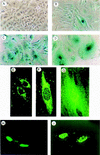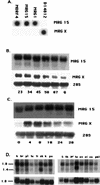Identification of a gene that reverses the immortal phenotype of a subset of cells and is a member of a novel family of transcription factor-like genes
- PMID: 9891081
- PMCID: PMC116076
- DOI: 10.1128/MCB.19.2.1479
Identification of a gene that reverses the immortal phenotype of a subset of cells and is a member of a novel family of transcription factor-like genes
Abstract
Based on the dominance of cellular senescence over immortality, immortal human cell lines have been assigned to four complementation groups for indefinite division. Human chromosomes carrying senescence genes have been identified, including chromosome 4. We report the cloning and identification of a gene, mortality factor 4 (MORF 4), which induces a senescent-like phenotype in immortal cell lines assigned to complementation group B with concomitant changes in two markers for senescence. MORF 4 is a member of a novel family of genes with transcription factor-like motifs. We present here the sequences of the seven family members, their chromosomal locations, and a partial characterization of the three members that are expressed. Elucidation of the mechanism of action of these genes should enhance our understanding of growth regulation and cellular aging.
Figures



References
-
- Bertram, M. J., et al. Genomics, in press.
-
- Bunn C I, Tarrant G M. Limited lifespan in somatic cell hybrids and cybrids. Exp Cell Res. 1980;127:385–396. - PubMed
-
- Clements J A, Matheson B A, Funder J W. Tissue-specific developmental expression of the kallikrein gene family in the rat. J Biol Chem. 1990;265:1077–1081. - PubMed
-
- Desbois C, Hogue D A, Karsenty G. The mouse osteocalcin gene cluster contains three genes with two separate spatial and temporal patterns of expression. J Biol Chem. 1994;269:1183–1190. - PubMed
Publication types
MeSH terms
Substances
Associated data
- Actions
- Actions
- Actions
- Actions
- Actions
- Actions
- Actions
Grants and funding
LinkOut - more resources
Full Text Sources
Molecular Biology Databases
